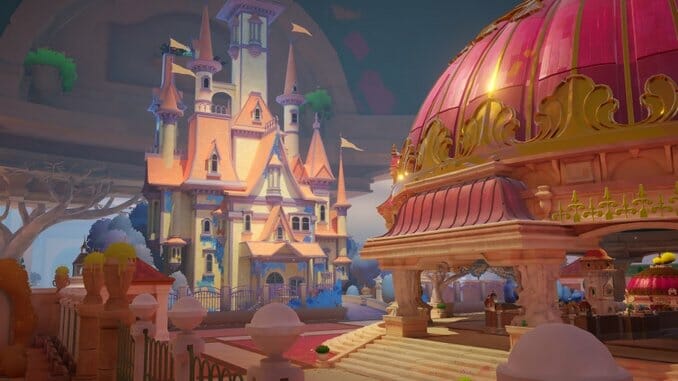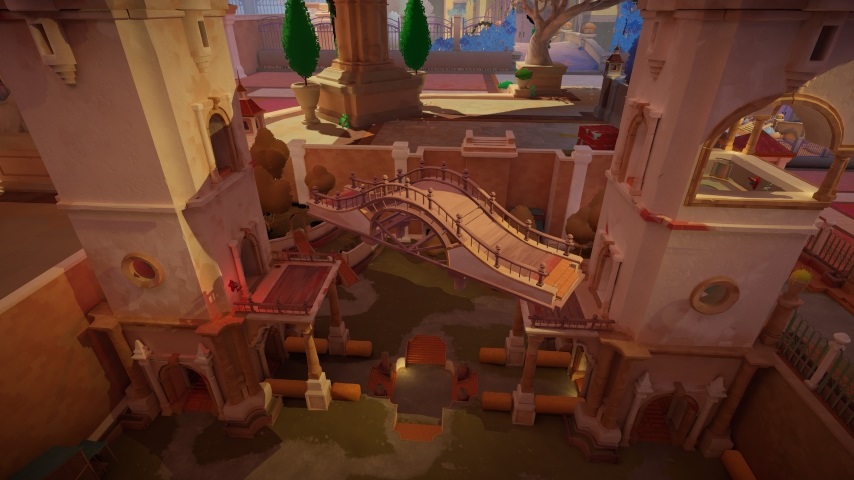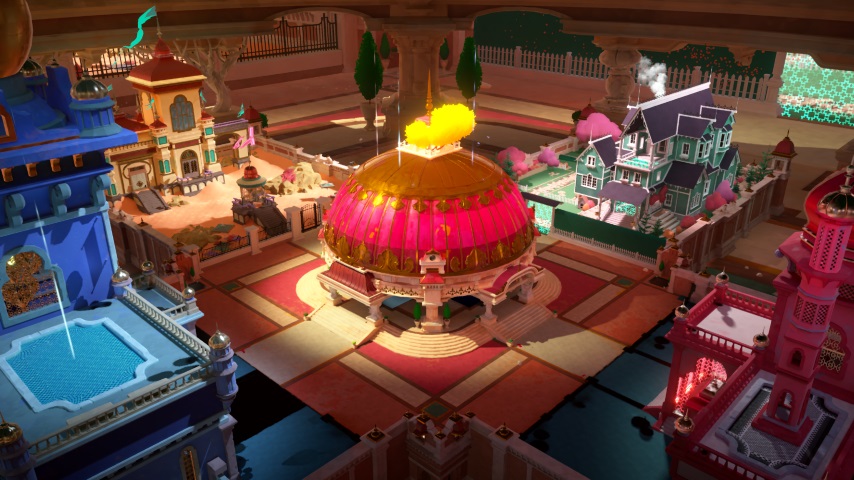
Relationships are hard. Writing them is hard, too. Maquette stands as proof: Annapurna’s smart, well-appointed puzzler puts forth a variety of sneakily challenging situations and scenarios, all in service of a deflating story about the collapse of a nondescript romance. You’ll need to enter this one with a committed love of puzzles, because the narrative engine that’s intended to drive you forward is a nonstarter.
At its heart is a striking central mechanic. You find yourself inside a dreamy pavilion that branches out into four distinct locations, almost like the hub of a theme park, but with buildings and scenic landscapes that feel unreal or half-remembered. At the very center is a dome, and within the dome is a smaller version of your surroundings. And within that smaller version is another dome—with another smaller copy of your world. Anything placed inside one dome is replicated in the other, at the appropriate scale; so a normal key in your human-sized realm would appear very small within the miniature world inside the dome. If you place that human-sized key inside that smaller world, though, a much larger key will now appear in the same spot within the regular-sized level. So a house key can become big enough to use as a bridge when needed, for example. You’ll use this technique to manipulate the size and scope of objects in order to solve various environmental puzzles and explore your surroundings.
There’s a dreamlike quality to the spaces you’ll explore, and when combined with the often abstruse solutions, it all recalls the surreal world of Myst. Maquette doesn’t rely solely on mystery, though. The reason everything around you feels vague and amorphous is because you’re exploring somebody’s memories, and particularly their memories of a crucial but ill-fated relationship.

Michael and Kenzie are a typical couple. They meet, they hang out, they grow close. Eventually they think they’re in love. Inevitably—painfully—they realize they’re not in love. You eavesdrop on pivotal moments in their lives together as you solve puzzles, the two represented on screen as hand-drawn birds that gradually come together and then fly apart. In between these short reveries you’ll occasionally see words appear on walls and buildings, sharing elliptic thoughts from one of the two lovers; these act as guideposts, pointing you towards your next puzzle.
These glimpses of Michael and Kenzie’s relationship are positioned as a kind of reward. You unlock them when you complete a puzzle and at the end of each chapter. They’re not very rewarding, though, because there’s not much to them. Propping up Maquette’s puzzles is a banal relationship drama that never comes together, featuring two underdrawn and unlikable characters who never quite earn our attention. The player essentially shifts through the shards of their time together, with these impermanent buildings and the puzzles within serving as obvious metaphors for the withering of their love.
Injecting lifelike emotion into a puzzle game is a worthwhile goal. Giving us something human, something real, to hang onto as we try to figure out what to do with all these colored crystals would give a game like Maquette a depth and resonance not found in most of its peers. And Maquette does poignantly tap into the mixed emotions following a breakup, that combination of self-doubt, shame and anger that bubbles through the sorrow.

The problem is this particular romance, these two specific characters, and what we see of their relationship.
As voiced by Bryce Dallas Howard and Seth Gabel, Kenzie and Michael don’t feel like real people, but off-putting facsimiles. Howard’s too theatrical, delivering her lines for the back row, and Gabel’s a little too soft-spoken, a little too unsure of himself. It doesn’t sound like a lack of confidence within Michael, but within the actor performing the character. A story like this hinges on the characters, on their believability and the audience’s ability to relate to or sympathize with them, and Howard and Gabel don’t pull it off.
There’s also a pacing issue. The game’s dialogue talks about cracks appearing in their relationship, but to us it feels more like an abrupt shatter. At the end of one chapter they’re more deeply in love than ever, and by the start of the next they’re needling each other like a couple that’s spent decades together. Within a few puzzles it reaches a rushed breaking point. It might sound a bit like the old joke about terrible food and such small portions, but for Michael and Kenzie’s breakup to hit us the way it should, we need to spend more time with them when they still thought they were in love.
For Maquette to really work, it needs to make us care about its characters. It needs to make us feel their connection, to fall in love with how they fell in love, and then to feel the growing alienation and the pain of their collapse. Unfortunately it doesn’t do that. The story that should compel us to keep playing instead becomes an annoying digression from what the game does well. These environments, those puzzles, and the size-changing gimmick that lets you solve them comprise a unique and fascinating vision that depends on the kind of esoteric thinking familiar from classic point-and-click adventure games. Instead of pulling us in deeper, though, Michael and Kenzie’s romance pushes us away. That’s the real tragedy of Maquette.
Maquette was developed by Graceful Decay and published by Annapurna Interactive. Our review is based on the PlayStation 4 version, played on the PlayStation 5. It’s also available for PC.
Senior editor Garrett Martin writes about videogames, comedy, music, travel, theme parks, wrestling, and anything else that gets in his way. He’s on Twitter @grmartin.